Today was our first launch of the year. We loaded up the newly-repaired Jeckyl and Hyde into a couple of cars and drove off to the same field nearby that we have been using for about a year and a half now.
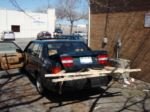
For once, the repairs that had to be made before today were minimal and done very quickly. A new center hanger had to be made, as well as a new solid baseball pouch, but that was all, and were easily done one afternoon in November. We had also determined the reason behind the failures of the secondary trigger from analysis of last summer's videos. The bottom line is that the cable used for the secondary trigger was not guided properly, and was therefore sneaking into the space between the central hanger and the arm, meaning that it was triggering too late. This was easily cured with the addition of a long guide on the end of the arm to make sure the cable routed properly.
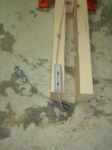
Analysis of the old video had also shown that the secondary was triggering too early for good launches, so the first thing we did after setting up was to shorten its length dramatically. We also set up with our longest sling, one roughly 7 foot in length, which turned out to be the wrong choice. We set up with 50 pounds of counterweight as always, and fired off the baseball. No real problems on the first shot, aside from a very flat trajectory and a disappointing distance of 180 feet. We were shooting into a bit of a headwind, which didn't help, but at least the secondary trigger triggered properly. The second shot was a carbon copy of the first, with the landing being in almost the exact same spot.
We shortened the secondary cable a little more, as it was still triggering early, and also backed off on our pin angle by roughly 15 degrees. This shot was interesting. It spiked into the ground right in front of the machine, it traveled maybe 5 feet forward of where it started off. The sling lines seemed to have gotten twisted around a bit, this may have caused the baseball to get caught in the pouch some. Unfortunately, it is tough to see the brown sling lines on the video, we need to change over to something more visible. We reset and fired again, in the same configuration, and the ball went slightly further, but still only about 80 feet, it was a very flat launch.
We decided it would be fun to try launching a golf ball with this thing, though Jason was convinced we would break something. Turns out that the only thing we broke was the ground, as the golf ball got launched into the ground at a fairly steep angle about 70 feet forward, despite backing off the pin angle by around 20 degrees. We decided that it wasn't worth our time to continue tuning for a golf ball, and put the baseball back in the pouch, not changing anything. Bang! 250 foot shot. Now we were getting back into the ranges we were in last summer, but still 100 feet shy of our first shot with this machine. Trajectory was around 45 degrees, a bit steep but decent.
The next 2 shots went 215 and 255 feet, after a slight decrease in pin angle. We lengthened the secondary cable out all the way it could go before these shots. Unfortunately, the wind was picking up and getting more inconsistent, and it was getting late too. We decided on shooting one more time, after taking 5 inches off the sling length. Unknown to us, however, the screw eye that held the fixed end of the secondary cable on the hanger was weakened after so many shots, and opened up during this final shot. Thus, the secondary did not trigger, and the counterweight smashed into the arm similar to what happened 4 times last summer. Unlike last summer, one of the bearing mounts split, the arm twisted with it, and the counterweight then hit the frame. The new baseball pouch also ripped out at both grommets simultaneously.
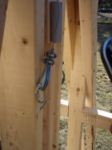
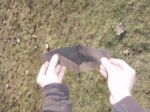
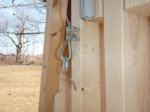
Naturally, this ended our day whether we were ready or not. The damage was pretty extensive, and while it is repairable, there are so many design issues with this machine that we wonder if it is even worth it. The counterweight axle is always bumping into the frame, though this seems to be largely due to improper spacing of the counterweight axle. The in riggers come too close to the hangers, though if we had a longer short arm or only a central hanger, this would not be an issue. And above all, the bearing mounts seem to have issues, as first we broke on off on an early test shot (though that was due to improper support), and now we split one. We had noticed a crack forming over the shots we took, and this last misfire was too much for the one mount. We are not sure at this moment what we are going to do, but if we do rebuild, at least we know what not to do in the future, and what to do.
One thing that we know contributed to our poor distances today was an excessively long sling. Video analysis has revealed that all shots were releasing way past arm stall. When the arm was stalling, the sling was barely parallel to the ground. In short, we needed to shorten our sling, which makes sense considering we were using a sling 140% the length of our long arm. We also need a longer secondary cable, as the longest we could make it only got the secondary trigger angle down to just over 100 degrees, we want it possibly as low as 70 degrees, definitely at least down to 90 degrees. One other thing that we noticed is that the machine was excessively violent today. The arm tip was consistently over swinging and hitting the ground, once it even flipped the trough over. There is clearly a lot of residual energy left in this machine, if we could just get that energy into the throw, we would be hitting massive distances. Also as a consequence of the extra energy, the sling was wrapping itself around the arm quite messily, often a dozen or more wraps. That's a new one for Jeckyl and Hyde. A summary of our shots follows:
| Shot # | Counterweight (Pounds) | Object | Distance (Feet) | Notes |
| 1 | 50 | baseball | 180 | Low trajectory, 105 degree secondary, 45 degree pin angle, post-stall release. |
| 2 | 50 | baseball | 180 | Low trajectory, 110 degree secondary, 45 degree pin angle, post-stall release. |
| 3 | 50 | baseball | 5 | Spiked in front of machine, 105 degree secondary, 30 degree pin angle, post-stall release, ball caught in pouch? |
| 4 | 50 | baseball | 80 | Bit of a spike as well, release way after stall, 105 degree secondary, 30 degree pin angle. |
| 5 | 50 | golf ball | 70 | Below horizontal trajectory, release after stall, 105 degree secondary, 10 degree pin angle. |
| 6 | 50 | baseball | 250 | Slightly above 45 degree trajectory, post-stall release, 105 degree secondary, 10 degree pin angle. |
| 7 | 50 | baseball | 215 | High trajectory, post-stall release, 105 degree secondary, 5 degree pin angle. |
| 8 | 50 | baseball | 255 | So-so trajectory, 105 degree secondary, 5 degree pin angle, post-stall release. |
| 9 | 50 | baseball | ----- | Secondary screw eye opened up, no trigger, big damage. |
More pictures are in the Jeckyl and Hyde Image Gallery, and a video of today's shots is on the Jeckyl and Hyde Videos Page.









